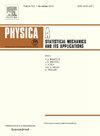The end of hyperbolic growth in human population and CO2 emissions
IF 2.8
3区 物理与天体物理
Q2 PHYSICS, MULTIDISCIPLINARY
Physica A: Statistical Mechanics and its Applications
Pub Date : 2025-01-31
DOI:10.1016/j.physa.2025.130412
引用次数: 0
Abstract
Using current empirical data from 10,000 BCE to 2023 CE, we re-examine a hyperbolic pattern of human population growth, which was identified by von Foerster et al. in 1960 with a predicted singularity in 2026. We find that human population initially grew exponentially in time as with years. This growth then gradually evolved to be super-exponential with a form similar to the Bose function in statistical physics. Around 1700, population growth further accelerated, entering the hyperbolic regime as with the extrapolated singularity year , which is close to the prediction by von Foerster et al. We attribute the switch from the super-exponential to the hyperbolic regime to the onset of the Industrial Revolution and the transition to massive use of fossil fuels. This claim is supported by a linear relation that we find between the increase in the atmospheric CO level and population from 1700 to 2000. In the 21st century, we observe that the inverse population curve deviates from a straight line and follows a pattern of “avoided crossing” described by the square root of the Lorentzian function. Thus, instead of a singularity, we predict a peak in human population at of the time width years. We also find that the increase in CO level since 1700 is well fitted by with = 40 years, which implies a peak in the annual CO emissions at the same year .
求助全文
约1分钟内获得全文
求助全文
来源期刊
CiteScore
7.20
自引率
9.10%
发文量
852
审稿时长
6.6 months
期刊介绍:
Physica A: Statistical Mechanics and its Applications
Recognized by the European Physical Society
Physica A publishes research in the field of statistical mechanics and its applications.
Statistical mechanics sets out to explain the behaviour of macroscopic systems by studying the statistical properties of their microscopic constituents.
Applications of the techniques of statistical mechanics are widespread, and include: applications to physical systems such as solids, liquids and gases; applications to chemical and biological systems (colloids, interfaces, complex fluids, polymers and biopolymers, cell physics); and other interdisciplinary applications to for instance biological, economical and sociological systems.

 求助内容:
求助内容: 应助结果提醒方式:
应助结果提醒方式:


